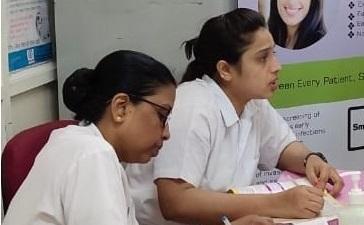Through a series of short articles, we will enable a gynaecologist with the necessary skills to do so.
Gynaecologist’s Guide to Enabling Cervical Health – Part 1: Who should be tested?

The health issues that a woman can experience range from minor infections in the external genitalia to growths in the uterus or ovaries. Some of these issues – such as mild PCOD – can easily be controlled by dietary changes whereas some – such as STDs and some types of cancers – may require education to bring on hygiene-related or lifestyle changes. The good news is, all of these issues can be corrected to a great extent when they are identified early.
Having said that, let us now see how cervical health issues can be identified early, especially considering that the cervix cannot be visualised by a woman herself, unlike most other body parts that are prone to frequent external infections. A gynaecologist is a woman’s singular counsel and confidante when it comes to examining the cervix and ensuring its health throughout her life.
In this article, we will list a few key aspects in enabling a gynaecologist with this skill.
- Identifying women who must be examined
- Convincing women to undergo a PV examination
- Equipping the OPD for a PV examination
- Counselling the woman and her family
- Treatment and follow up protocol
Part 1: Identifying women who must be examined:
For the sake of simplicity, let us all assume that we are talking only about non-pregnancy related health issues in this article.
A woman typically tends to go to a gynaecologist only when the symptoms of a health issue are interfering with her daily life. Example is when she experiences discharge that is foul smelling, excessive. Such symptoms would embarrass her or even interfere with her sexual life. Another example is if she has symptoms such as itchiness which could cause physical discomfort. The severity and frequency of these symptoms determines when she goes to a gynaecologist. In some cases, the symptoms may even be deceptive – she may experience a burning sensation which can be mistaken for urinary tract infection thus leading her to go to a urologist instead of a gynaecologist. In some cases, the symptoms may not even be visible till the health issue has turned into a significant hazard. As worrisome as all the above sound, the most disconcerting case is one where the woman knows there is something seriously wrong but chooses not to go to the doctor simply because she may not have the time or money, or she may be scared about the examination procedure and/or the subsequent invasive treatment as she imagines, or she may have fear of the social stigma or inferences drawn by her partner or family – however wrong they may be in reality.
As you can see, there are several deterrents to maintaining cervical health when it comes to patient behaviour:
- Patient may not present the known symptoms at all
- Patient may not identify symptoms early enough
- Patient may mistake a symptom
- Patient may describe it insufficiently thus misleading the physician to misdiagnose and mistreat
- Patient may ignore the symptoms knowingly for various reasons
The underlying causes can be many such as:
- Cost of test and treatment including travel over multiple visits,
- Hassle and time taken for test including the multiple visits, travel, and wait time,
- Discomfort of the test procedure itself,
- Lack of awareness of what to watch out for, the significance of each symptom, and modern tests that are single-visit, not painful, and affordable and the role they play in avoiding invasive and costly treatments,
- Lack of education combined with lower economic status that causes financial dependence on family and also promotes myths about reproductive health
Abetting these factors are facts such as lack of infrastructure i.e., pathology labs, experts, and logistic support, in LMIC countries like India. To complicate matters more, cytopathology was believed to be the only way to check for cervical infections. Let us table the discussion about cytopathology and its alternatives for a minute (we’ll get to it soon in this series). The main point is: because countries like India have to balance the load on the infrastructure, it was recommended that women above the age of 40 should be screened for cervical cancer, as that seemed to be the worst outcome observed related to cervical health and because cervical cancer would take 10-15 years to start presenting its symptoms clearly. This has caused a great myth to be prevalent even in the gynaecologist community – women under 40 do not need cervical health testing!
Eligible cases for cervical health check-up are sexually active women from 25 years to 65 years, without any recent surgery or trauma, and who are not ANCs, who are 6 months+ post partum if they are PNCs.
In summary of today’s topic, one can say that if every gynaecologist starts testing all qualifying women from 25 years to 65 years – at least opportunistically in their OPDs and when possible through community programs, we would be taking the biggest and most important step towards identifying cervical health issues early.
Next in series: Convincing these women to undergo a PV examination

